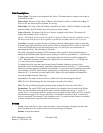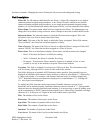Field Descriptions
Fileset Name. The name to be assigned to the fileset. This name must be unique to the realm in
which HPSS resides.
Fileset State. The state of the fileset. If Read is ON, the fileset will be available for reading. If
Write is ON, the fileset will be available for writing.
File Family. The name of the File Family assigned to this fileset. If the File Family is to be other
than the default, the File Family must have been previously created.
Class of Service. The name of the Class of Service assigned to this fileset. This menu will
display the available Classes of Service.
Advice - File Family & Class of Service fields are optional. They provide the capability to force
all data stored in the fileset to be assigned to a particular file family and/or class of service.
User Data. Any name or other data (up to 128 bytes) that the administrator wishes to associate
with the fileset. The information can be ASCII or binary, although ASCII is easier to work with
in this field. HPSS does not use this field in any way; it is strictly for user convenience in
annotating the fileset. The field may be left blank.
The field is displayed as printable ASCII characters where possible. Non-printable bytes are
displayed in backslash-octal notation, where each byte is shown as a backslash (“\”) followed by
a 3-digit octal number. For example, a tab character (decimal value 9) would be displayed as
“\011”. Backslash characters are themselves displayed as two backslashes (“\\”). Trailing null
(i.e., zero) bytes are not displayed.
To modify this field, enter data in the same format. Printable characters (except for the
backslash) can be entered normally. Backslash characters must be entered as “\\”. Non-printable
characters must be entered in backslash-octal notation. You need not specify leading zeros on the
octal numbers, EXCEPT when the non- printable byte is followed by a printable octal digit
character (0-7). In that case you must specify all 3 digits of the octal number to distinguish it
from the printable character following.
Core Server. The name of the Core Server which will create and manage the fileset.
UID. The User ID identifying the user owning the root node of the fileset.
GID. The Group ID identifying the principal group owning the root node of the fileset.
Permissions. The initial UNIX-style permissions to be assigned to the root node of the fileset.
There are nine checkboxes arranged in a matrix with the columns specifying "r" (read), "w"
(write) and "x" (execute) permissions, and the rows specifying the three classes of users to which
the permissions apply (User, Group, and Other). If a checkbox contains a check, it means that
access is permitted. For example, if the checkbox in the "x" column and the Group row contains
a check, it means that Group users have execute access.
Buttons
Create. Creates the fileset. If the create succeeds, a success message will appear on the status
line at the bottom of the window; otherwise an error message will appear.
Dismiss. Closes the window.
HPSS Management Guide November 2009
Release 7.3 (Revision 1.0) 311


















